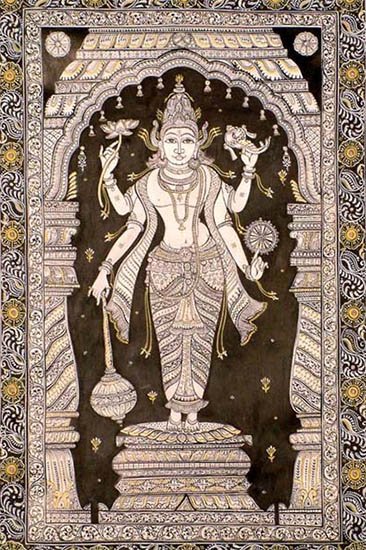Candrapitha, Candrapīṭha, Candra-pitha: 3 definitions
Introduction:
Candrapitha means something in Hinduism, Sanskrit. If you want to know the exact meaning, history, etymology or English translation of this term then check out the descriptions on this page. Add your comment or reference to a book if you want to contribute to this summary article.
Alternative spellings of this word include Chandrapitha.
In Hinduism
Shilpashastra (iconography)
Source: Wisdom Library: Śilpa-śāstraCandrapīṭha (चन्द्रपीठ) is a Sanskrit technical term, referring to a type of pedestal (pīṭha), used in the construction of liṅgas. It is named after the kind of moulding (candra). The word liṅga refers to a symbol used in the worship of Śiva and is used thoughout Śaiva literature, such as the sacred Āgamas.

Shilpashastra (शिल्पशास्त्र, śilpaśāstra) represents the ancient Indian science (shastra) of creative arts (shilpa) such as sculpture, iconography and painting. Closely related to Vastushastra (architecture), they often share the same literature.
Shaktism (Shakta philosophy)
Source: Google Books: ManthanabhairavatantramCandrapīṭha (चन्द्रपीठ) refers to the “sacred seat of the Moon”, according to the commentary (vyākyā) on the Ṣaṭsāhasrasaṃhitā, an expansion of the Kubjikāmatatantra: the earliest popular and most authoritative Tantra of the Kubjikā cult.—Accordingly, “[...] : That is the energy of the New Moon (amākalā) and is called the sacred seat of the Moon [i.e., candrapīṭha]. If the goddess is conceived to be the Moon, she is then in the form of the left channel, emanation, the entry (of the breath), and the north. How is she when she is otherwise? She is ‘located in the midst of the sixteen-spoked (Wheel)’. The sixteen vowels are the energies of the Moon. Thus, anackā, the sixteenth energy, is Kubjinī, in the form of Kuṇḍalinī. This is the meaning”.

Shakta (शाक्त, śākta) or Shaktism (śāktism) represents a tradition of Hinduism where the Goddess (Devi) is revered and worshipped. Shakta literature includes a range of scriptures, including various Agamas and Tantras, although its roots may be traced back to the Vedas.
Languages of India and abroad
Sanskrit dictionary
Source: Cologne Digital Sanskrit Dictionaries: Aufrecht Catalogus CatalogorumCandrapīṭha (चन्द्रपीठ) as mentioned in Aufrecht’s Catalogus Catalogorum:—[tantric] Quoted by Narasiṃha in Tārābhaktisudhārṇava. Catal. Io. p. 897.
Sanskrit, also spelled संस्कृतम् (saṃskṛtam), is an ancient language of India commonly seen as the grandmother of the Indo-European language family (even English!). Closely allied with Prakrit and Pali, Sanskrit is more exhaustive in both grammar and terms and has the most extensive collection of literature in the world, greatly surpassing its sister-languages Greek and Latin.
See also (Relevant definitions)
Partial matches: Pitha, Candra, Pita.
Starts with: Candrapithatantra.
Full-text (+43): Somavva, Amritavva, Tripurantaka, Kalahapriya, Vadavamukha, Dhumrakshi, Vyalakshi, Candradevyavva, Khecaravva, Sugriva, Durasada, Someshvara, Dirgha, Vikarala, Varaviresha, Devadatta, Capala, Dhaneshvara, Mantrangi, Sarvajnakamala.
Relevant text
No search results for Candrapitha, Candrapīṭha, Candra-pitha, Candra-pīṭha; (plurals include: Candrapithas, Candrapīṭhas, pithas, pīṭhas) in any book or story.